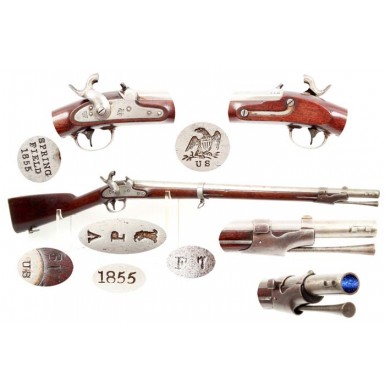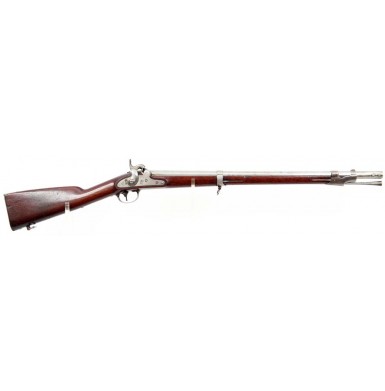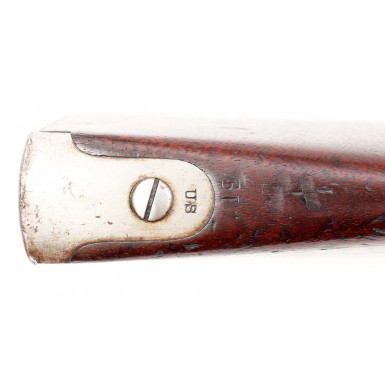1847 Sappers & Miners Musketoon - Fine & Scarce
- Product Code: FLA-3084-SOLD
- Availability: Out Of Stock
-
$1.00
In early 1847 the US Board of Ordnance met to evaluate three new patterns of “musketoons” that had been produced at the Springfield Arsenal during 1846. The designs had been on the drawing board since at least 1844, but the model guns were not prepared until late in 1846, probably because of other more important production that was going on at the Springfield Arsenal. These three pattern guns would be adopted and approved by the Ordnance Department as the US M-1847 Sappers & Miners (Engineers) Musketoon, the US M-1847 Artillery Musketoon and the US M-1847 Cavalry Carbine. All three patterns were quite similar, with minor differences in their furniture and features that adapted them to the needs of the service branch to which they would be issued. Both the Sappers & Miners Musketoon and the Artillery Musketoon had iron furniture, were equipped with sling swivels for carry by men on foot, and were capable of mounting a bayonet. The Cavalry Carbine design allowed it to be slung from a sling and ring system for a mounted man, and this by the definitions of the time made it a “carbine” and not a “musketoon”. The cavalry carbine alone had brass furniture and had no provision for a bayonet. In all major features the guns were nearly identical, being single shot percussion muzzleloaders with an overall length of 41 1/16”. The guns had a nominally 26” long, round, smoothbore barrel of .69 caliber, secured to the stock with a pair of barrel bands, with the upper band being double strapped. The locks were all identical, being smaller versions of the US M-1842 percussion lock then in use on the US M-1842 infantry musket. The primary differences lay in the furniture, carrying systems, rammer systems and type of bayonet mounting systems (if any) that were used on the guns. Additionally, the barrel of the cavalry musketoon was actually 1/16” longer than the two musketoons, being 26 1/16” in length instead of 26”. While the family of US M-1847 “musketoons” originally contained only three models, within a decade no less than 10 different variants existed, due to modifications, design improvements, and refitting of some guns for other service. The family of arms went into production in 1847, with the first guns being completed and accepted into stores during that calendar year being a pair of M-1847 Cavalry Carbines and 200 US M-1847 Sappers & Miners Musketoons. The family of arms remained in production for nearly a decade at Springfield, with the final guns produced being 33 Sappers & Miners Musketoons, delivered in 1856. During the production run a total of 10,033 M-1847 carbines and musketoons were manufactured, with 1,030 being Sappers & Miners Musketoons, 3,210 being Artillery Musketoons and 5,802 being Cavalry Carbines. During the final years of their service, many of the M-1847 Cavalry Carbines and some M-1847 Sappers Musketoons were altered to artillery musketoons (or “cadet musketoons”), and were issued to the various states under the Militia Act of 1808 for use by military school cadets.
The US M-1847 Sappers & Miners Musketoon was the first of the M-1847 family of arms to see production in any significant quantity and has the distinction of being the last of the 1847 pattern arms to remain in production at Springfield. The musketoons were produced during two specific periods, during 1847-1848 and during 1855-1856. The first batch of carbines were 450, manufactured during the end of 1847 and early 1848 (200 and 250 in each year, respectively). Manufacture of the Sappers musketoon did not resume again until 1855, when 547 were produced, and the production run ended in 1856 after the final 33 were manufactured. In all, only 1,030 of the Sappers & Miners musketoons were produced, making it the least common model of the 1847 family of arms. In most respects the Sappers & Miners musketoon was quite similar to the Artillery musketoon. It was iron mounted and equipped with a pair of sling swivels, one on the lower barrel band and one in the toe of the stock. The musketoon has a trumpet shaped, iron ramrod, essentially a scaled down version of the ramrod that was used with the M-1842 Musket, which was threaded at the end to accept cleaning tools and implements. The most identifying feature of the Sappers Musketoon was its massive 2-section bayonet lug that allowed a large saber bayonet to be mounted on gun. The bayonet was unique among US saber bayonets, and was styled like a Roman gladius, and bearing a strong resembling the US M-1832 Foot Artillery Sword, which was also based upon the Roman foot soldier’s sword. The mounting lugs consisted of a typical saber bayonet style stud on the rear strap of the upper barrel band, and a second stepped guide lug on the right side of the barrel near the muzzle. In order to keep the barrel band with the stud from rotating, the upper rear of the barrel band strap was mortised to engage a small stud on the top of the barrel. This extra reinforcement helped to prevent any motion of the band when it was under the stress of the large bayonet. The massive bayonets were produced the N.P. Ames Company of Cabbotville, MA, just as the M-1832 Foot Artillery swords were. The first 200 bayonets were ordered from Ames in December of 1846 and had fullers in the blades, similar to those on the artillery swords. The second order for bayonets was placed in February of 1847, and specified that the fullers were not to be included in the blades. An additional 500 Sappers & Miners bayonets were ordered from Ames in February of 1855, with the last order for 33 bayonets being placed in November of that year. The bayonet had an overall length of about 26 ¾” with a 22” double-edged gladius style blade and a 5 ¾” brass hilt with a fish scale pattern cast into the grip. The cross guard had two forward swept quillons and mounted a large brass muzzle ring on the reverse, complete with a rotating iron locking ring to secure the bayonet to the forward lug at the muzzle of the musketoon. A brass-mounted scabbard of black bridle leather accompanied the bayonet, with the upper mount having a circular stud to engage a bayonet frog on the engineers’ belt. An alphanumeric mating mark was struck on the upper rear of the pommel cap, which matched the bayonet to the musketoon it had been had fit to. The musketoons were marked with the same style alphanumeric mark on the upper portion of the front barrel band’s rear strap. It is clear that the bayonet was intended to be used as much as tool as a weapon, as it would make a fine falchion, machete or even impromptu excavating tool. The M-1847 Sappers & Miners musketoon remained in general service until it was replaced by the US M-1855 Rifle, which was available in sufficient quantities for issue to the Corps of Engineers during the latter portion of 1858. During late 1856 and early 1857, a number of the M-1847 Sappers musketoons in storage at Springfield were altered to the “Artillery” configuration, by removing the saber bayonet lugs and adding a socket bayonet lug under the muzzle. In many cases the sling swivels were removed as well. These guns were subsequently issued to states as “cadet musketoons”. Between October of 1856 and the end of 1857, some 228 Sappers musketoons were so altered, roughly a quarter of the total production. With only 802 un-altered examples remaining in military service when the guns were officially deemed obsolete, it is easy to understand why original configuration US M-1847 Sappers & Miners Musketoons are extremely difficult to find on the collector market more than 150 years later.
This example of the scarce US M-1847 Sappers & Miners Musketoon is in VERY FINEcondition. The musketoon is clearly marked on its lock with a “Spread Winged Eagle” over the letters U S and in three vertical lines to the rear of the hammer SPRING / FIELD / 1855. This makes this musketoon one the second batch of arms manufactured at Springfield when the guns were put back into production during 1855-56. The tang of the breech plug is marked with a matching 1855 date as well. The left upper barrel breech is clearly and crisply marked with the usual V / P / (EAGLE HEAD) view, proof and acceptance marks of Springfield Arsenal. The stock flat opposite the lock remains very crisp, but shows no inspection cartouche, suggesting that this may have been part of a small group of Sappers & Miners musketoons that were issued to the state of New York from the final production run. The tang of the iron buttplate is correctly marked U.S.. Forward of the butt plate tang, in the wood of the stock is the rack number 31. The upper rear strap of the front barrel band is marked with the alphanumeric mating mark F 7 to match the musketoon with the bayonet that was fit to it. The metal of the musketoon has been very lightly cleaned and has a mostly medium pewter gray patina, with some very lightly scattered patches of darker discoloration from age and oxidation. This is mostly scattered like salt and pepper. The barrel itself is mostly smooth with only some very lightly scattered pinpricking present around the breech and bolster area, the top of the breech and the muzzle. The balance of the barrel remains quite smooth. The bore of the musketoon is in about GOOD+ to NEAR VERY GOOD. It shows patches of bright and dark metal, with scattered light to moderate pitting along its length and a few patches of more serious surface roughness as well. A good scrubbing with a bronze brush will probably significantly improve the condition of the bore, as some of the dark spots and roughness may simply be old dirt and debris. As is often the case on these Engineer’s Musketoons, there are some scattered light dings in the barrel and on the barrel bands, especially in the area where the massive bayonet mounted to the gun. The two-notch guide lug on the right side of the barrel, near the muzzle shows impact and wear marks as well, but remains in good solid condition, brazed correctly to the barrel. The upper barrel band fits appropriately and mates perfectly with the reinforcement stud on the top of the barrel, exactly as it should. The original brass sight is place on the front strap of the upper barrel band. The rear barrel band matches the patina of the barrel quite well and retains its original sling swivel on the stud below the stock. The triggerguard has a smooth, patchy brown patina over the pewter gray base metal color. The lower sling swivel, mounted to the plate in the toe of the stock has a similar patina, and the original swivel remains in place on the stud in that location as well. The buttplate matches the balance of the gun and is free from the excessive wear and pitting often encountered on a steel musket buttplate. The lock of the musketoon functions crisply and correctly on both the half cock and full cock positions, and is mechanically excellent. The original trumpet shaped ramrod is present in the rammer channel under the barrel and it is full length, with good threads at the opposite end. The stock of the musketoon is in equally nice condition and rates about VERY FINE as well. It retains sharp, strong lines and crisp edges and does not appear to have ever been sanded. The stock is free of any breaks, cracks or repairs and is full length and solid. There are some rubs and minor scratches on the flat, opposite the lock, but nothing significant. Otherwise, the stock shows only some scattered bumps, dings, and minor mars from service, handling, use and storage.
Overall this very nice and complete, all original example of a very scarce US Engineer’s Musketoon. The US M-1847 Sappers & Miners Musketoon was produced in very small qualities and after the alteration of 228 to the Artillery/Cadet variant, only 802 remained in their original configuration. These guns are quite scarce today and when they are encountered they are often very worn and show hard use. This is an incredibly crisp and sharp example that you would have a very hard time upgrading in your collection. These unique musketoons that were issued to the US Corps of Engineers are not easy to find for sale and are rarely available in this condition. You will be glad to add the scarce musketoon to your collection of US carbines. I have two original M-1847 Sappers & Miners bayonets in inventory right now, both of which fit this musketoon. One is an 1847 dated, fluted blade example without a scabbard and the other is an 1855 dated example (the same as this musketoon) with a scabbard. Please feel free to discuss adding one of these bayonets to the gun when you purchase it.
SOLD







